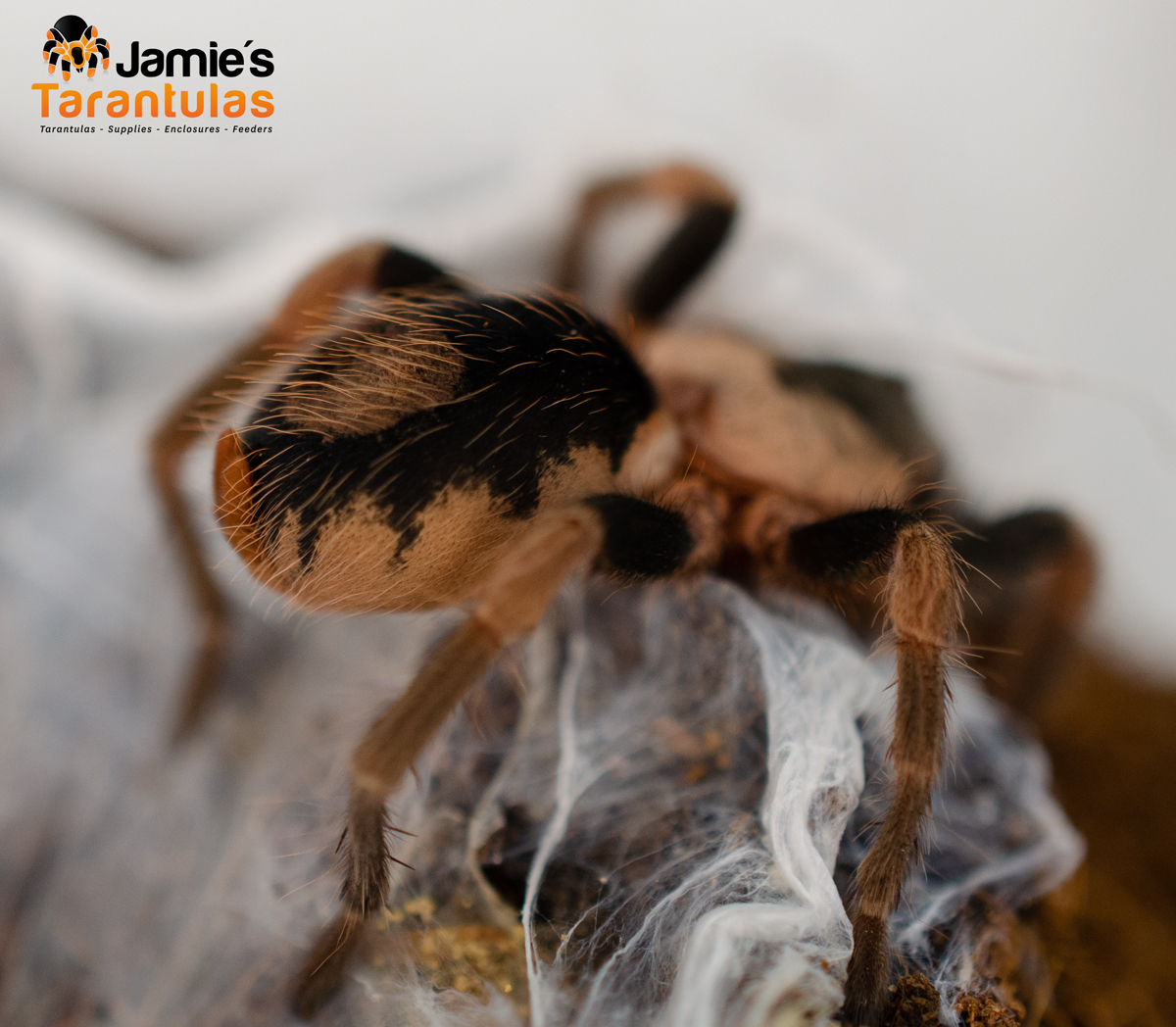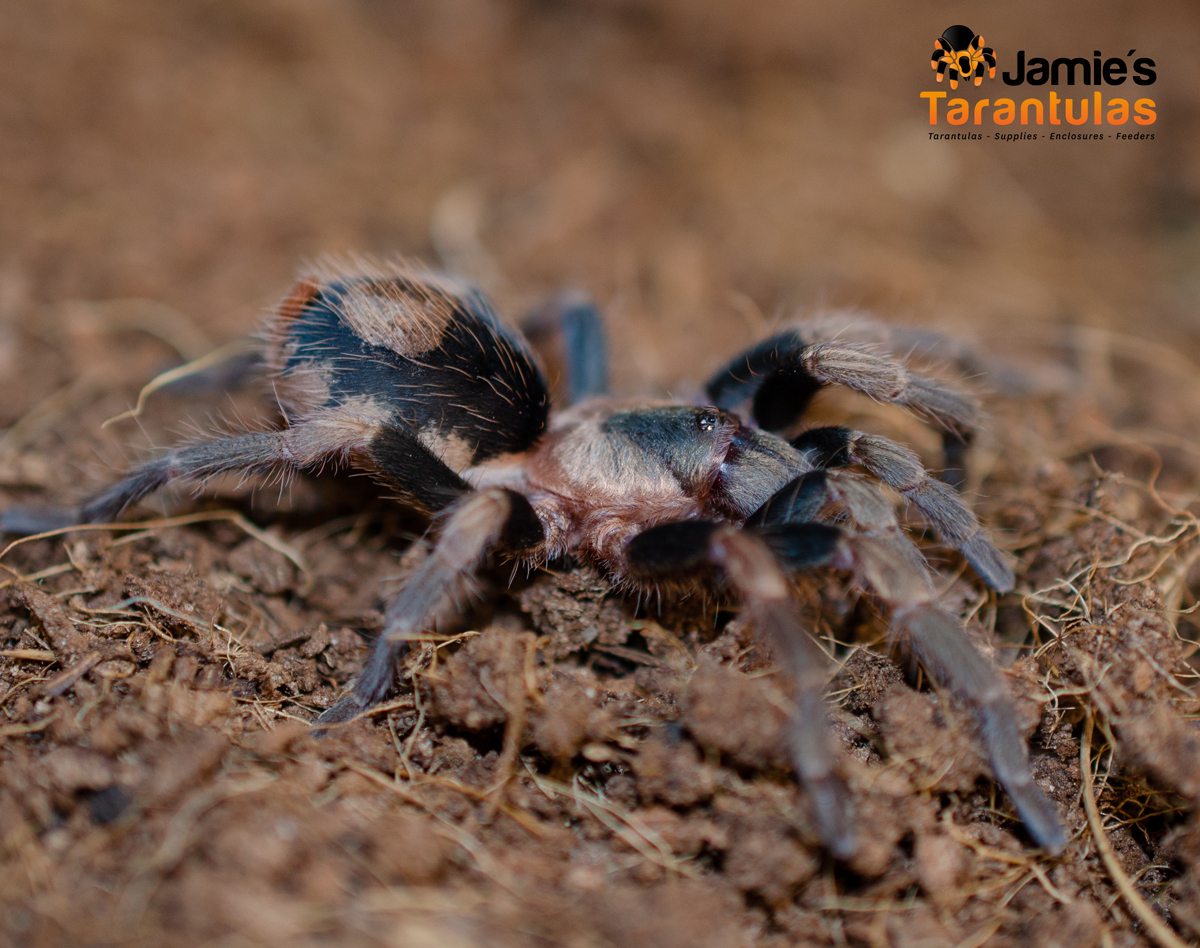On their carapace they have a triangle reminiscent of B. emilia. Their knees are striped and their banded legs have some structural blues. If that's not enough, all the way around their abdomen they've got what looks like orange flames burning over a black background.

Their unique colors and patterns are just icing on the cake. These tiny tarantulas are surprisingly hardy and vigorous. Specimens over 1" or so are not out of reach for a beginner.
What is cf? Cf is the abbreviated latin confer (which means ‘to evaluate’) In short, this means the specimen has most of defining characteristics of the species indicated and thus is a likely candidate. We are currently waiting to see if these specimens collected from Oaxaca, Mexico are truly one and the same as the Cardiopelma mascatum originally described in 1999.
Cardiopelma cf. mascatum have been found to occur in the mountains and borders south-east of Oaxaca City. While there is a seasonal wet period, most of the year the climate can be quite dry.
Currently they are quite rare in the hobby. We hope to have this amazing species available more often.

Origin: New World. Current hobby specimens of "Cardiopelma cf. mascatum" are native to Oaxaca, Mexico.
Difficulty: Beginner to Intermediate
Type: Terrestrial
Adult Size: 2-2 1/2"
Growth speed: Medium
Longevity: Males 4-6 years, females 8-16 years
Temperament: I find they can be skittish and may flee and will sometimes flick hairs if disturbed. Bites are rare and not considered medically significant.
Bite potency: Mild
Urticating hairs: Yes
Ideal Temperature: 70 to 75°
Humidity: Low to Medium
Fun Fact: Currently the only Cardiopelma there is still some uncertainty about the proper name of the specimens circulating in the hobby. It's exciting to have something so new and unique they we're just beginning to learn about.

Enclosure: For most small spiderlings under about 3/4-1" we recommend the Terrestrial Spiderling Enclosure Kit. Specimens over about 1" or so can be housed in a Terrestrial Juvenile Enclosure Kit and depending on the mature size of that particular specimen and how the enclosure is set-up it could possibly even be a permanent enclosure for this dwarf tarantula. Specimens over 2" will have a lot of space in a 7x7x11" complete terrestrial enclosure . Click HERE to find out how to you measure a tarantula.
Substrate: Cocofiber, vermiculite, peat moss and/or potting soil (or a mix) are all excellent substrate choices. Please make sure the substrate you choose is organic and chemical/fertilizer free. Do not use sand, pebbles, sharp rocks or wood chips or anything else that could potentially cut or injure the tarantula.
I find if provided with deep substrate this species will often build it's own burrow. If preferred, Cork tubes half buried in substrate can provide a starter area for a juvenile or adult specimen.
Water: Larger spiders 2” and over can be provided with a shallow water dish if desired although it is not necessary. The water bowl should be rinsed our every time it is refilled.
Feeding: Adults will eat every 7-14 days depending on the size of the spider and it's prey. Spiderlings should eat more often, every 7 days or so. We feed all our tarantulas B. lateralis roaches. A more detailed feeding, misting & troubleshooting guide can be found here: https://jamiestarantulas.com/guides/
Good Husbandry: Keep your tarantulas enclosure clean. food waste left in the enclosure will invite mold, mildew, mites, flies and other pests. The substrate does not need to be changed unless it is moldy, overly filthy or otherwise unfit for the tarantula. It is advised to remove uneaten prey items after a few minutes to hours. If using a feeder who will not “bother” a tarantula such as dubia roaches it is alright to leave them in the enclosure as long as they are not causing stress to the specimen.





Leave a Comment - Reply to